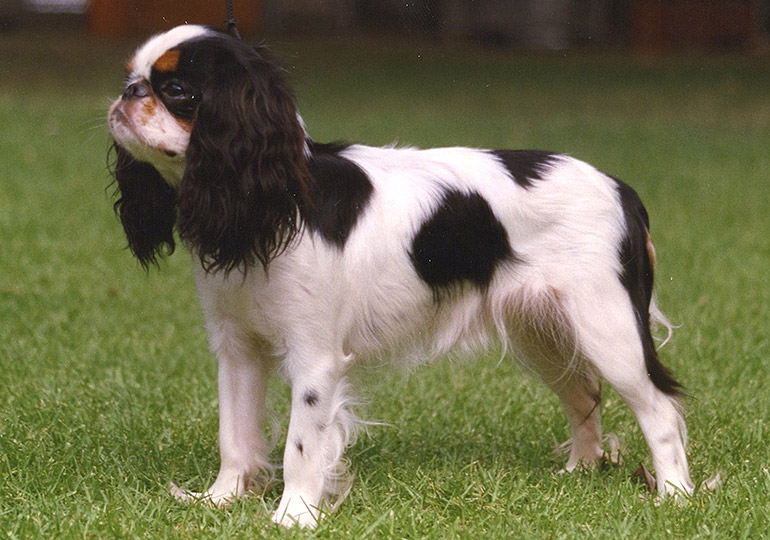King Charles Spaniel
Breed Details
Size:
Exercise Requirements:
Grooming Requirements:
3.5-6 Kg (Approx)
10-12 years (Approx)

Appearance
The King Charles has large dark eyes, a short nose, a high domed head and a line of black skin around the mouth.[3]On average, it stands 9 to 11 inches (23 to 28 cm) at the withers, with a small but compact body. It has the long pendulous ears typical of a spaniel and its coat comes in four varieties, trait it shares with its offshoot, the Cavalier King Charles Spaniel.
They come in Black & tan, Tricolour, Blenheim, Ruby.
Originally, each of these colour patterns was regarded as a separate breed, but in the late 1800s the four varieties were consolidated into a single breed.
Like its larger cousin, the Cavalier King Charles Spaniel, the King Charles Spaniel has a silky, often slightly wavy coat. It tends to be shorter than that of Cavaliers & is an easy care coat.
History
The King Charles Spaniel (also known as the English Toy Spaniel) is a small dog breed of the spaniel type. In 1903, the Kennel Club combined four separate toy spaniel breeds under this single title. The other varieties merged into this breed were the Blenheim, Ruby and Prince Charles Spaniels, each of which contributed one of the four colours available in the breed.
Thought to have originated in the Far East, toy spaniels were first seen in Europe during the 16th century. They were made famous by their association with King Charles II of England (1630–1685) and have been linked with English royalty since the time of Queen Mary I (1516–1558). Members of the breed have been owned by Grand Duchess Anastasia Nikolaevna of Russia, and Queen Elizabeth II.
The King Charles Spaniel and the other types of toy spaniels were crossbred with the Pug in the early 19th century to reduce the size of the nose, as was the style of the day. The 20th century saw attempts to restore lines of King Charles Spaniels to the breed of Charles II's time. These included the unsuccessful Toy Trawler Spaniel and the now popular Cavalier King Charles Spaniel. The Cavalier is slightly larger, with a flat head and a longer nose, while the King Charles is smaller, with a domed head and a flat face.
Historically the breeds that were merged into the King Charles Spaniel were used for hunting; due to their stature they were not well suited. They have kept their hunting instincts, but do not exhibit high energy and are better suited to being lapdogs.
Temperament
The King Charles is a friendly breed, to the extent that it is not typically as suitable as a watchdog as some breeds, though it may still bark to warn its owners of an approaching visitor, It is not a high energy breed, and enjoys the company of family members, being primarily a lapdog. Although able to bond well with children and tolerant of them, it will not accept rough handling. It prefers not to be left alone for long periods. Known as one of the quietest toy breeds, it is suitable for apartment living.
The breed can tolerate other pets well, although the King Charles still has the hunting instincts of its ancestors and may not always be friendly towards smaller animals. It is intelligent enough to be used for obedience work and, due to its stable temperament, it can be a successful therapy dog for hospitals and nursing homes.
Care/Grooming
The King Charles Spaniel has a silky, often slightly wavy coat. An easy care coat, only needing a brush about once a week.
Breeders
Currently no Breeders in SA for this Breed

